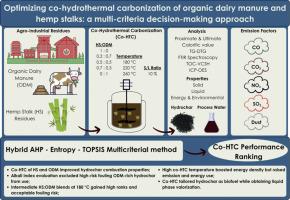有机牛粪与大麻秸秆共水热炭化优化:多准则决策方法
IF 9.5
Q1 ENERGY & FUELS
引用次数: 0
摘要
对环境可持续性实践日益增长的需求凸显了将农业残留物转化为高效生物燃料的重要性。本研究以有机乳肥(ODM)和大麻秸秆(HS)渣为原料,通过水热共炭化(co-HTC)来提高其燃烧性能,并评估其液相增值潜力。HTC实验在180、220和260°C下进行,HS:ODM比(1:0、3:1、1:1、1:3、0:1)不同,并评估了烃类的物理化学性质、燃烧行为和排放因子估算。混合层次分析法(AHP) -熵- TOPSIS多标准分析综合了技术,环境和工艺相关指标对碳氢化合物进行排名。主要研究结果表明,在低至中温条件下,混合剂具有明显的协同效应,可以提高能量产量、燃烧反应性和固相碳回收率。尽管HY180-0:1获得了最高的综合性能得分,但其碱指数(AI)超过了高风险结垢阈值(0.34 kg/GJ),其他富含odm的碳氢化合物也超过了这一阈值,将它们排除在实际燃烧之外。相比之下,HY180-0.3:0.7和HY180-0.7:0.3结合了高的多标准性能和可接受的AI水平,成为最具燃烧可行性的碳氢化合物。这项工作突出了系统地将多标准决策与污染风险评估相结合的新颖性,确保了最佳性能和运营可行性,支持可持续的废物转化为能源的途径,并推进了农业部门的循环经济实践。研究结果表明,co-HTC可以通过利用互补原料特性来战略性地定制碳氢化合物特性。通过促进可再生燃料生产(可持续发展目标7)、推进循环废物管理(可持续发展目标12)和减少排放(可持续发展目标13),该方法加强了碳氢化合物作为清洁能源载体的作用。本文章由计算机程序翻译,如有差异,请以英文原文为准。

Optimizing co-hydrothermal carbonization of organic dairy manure and hemp stalks: a multi-criteria decision-making approach
The increasing demand for environmental sustainability practices highlights the importance of valorizing agricultural residues into efficient biofuels. This study focuses on the co-hydrothermal carbonization (co-HTC) of organic dairy manure (ODM) and hemp stalk (HS) residue to enhance the combustion performance of the hydrochar and assess liquid-phase valorization potential. HTC experiments were conducted at 180, 220, and 260 °C with varying HS:ODM ratios (1:0, 3:1, 1:1, 1:3, 0:1), and hydrochars were evaluated for physicochemical properties, combustion behavior, and emission factors estimation. A hybrid Analytic Hierarchy Process (AHP) – Entropy – TOPSIS multicriterial analysis integrated technical, environmental, and process-related indicators to rank the hydrochars.
Key findings indicate clear synergistic effects at low to moderate temperatures, where blending improved energy yield, combustion reactivity, and solid-phase carbon recovery. Although HY180–0:1 achieved the highest overall performance score, its Alkali Index (AI) exceeded the high-risk fouling threshold (> 0.34 kg/GJ), as did other ODM-rich hydrochar, excluding them for practical combustion. In contrast, HY180–0.3:0.7 and HY180–0.7:0.3 emerged as the most combustion-viable hydrochars, combining high multi-criteria performance with acceptable AI levels.
This work highlights the novelty of systematically integrating multi-criteria decision-making with fouling risk assessment, ensuring both optimal performance and operational feasibility, supporting sustainable waste-to-energy pathways, and advancing circular economy practices in the agricultural sector. The findings demonstrate that co-HTC can strategically tailor hydrochar properties by leveraging complementary feedstock characteristics. By enabling renewable fuel production (SDG 7), advancing circular waste management (SDG 12), and mitigating emissions (SDG 13), this approach strengthens the role of hydrochar as a clean energy carrier.
求助全文
通过发布文献求助,成功后即可免费获取论文全文。
去求助
来源期刊

Energy nexus
Energy (General), Ecological Modelling, Renewable Energy, Sustainability and the Environment, Water Science and Technology, Agricultural and Biological Sciences (General)
CiteScore
7.70
自引率
0.00%
发文量
0
审稿时长
109 days
 求助内容:
求助内容: 应助结果提醒方式:
应助结果提醒方式:


